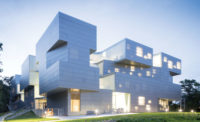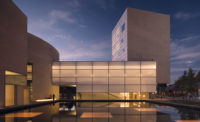The new Markel Center at Virginia Commonwealth University's Institute for Contemporary Art (ICA) in Richmond anchors its busy corner site at the edge of campus like an urban-scaled sculpture, its cool, pre-weathered titanium zinc and etched glass acting in concert to form a building that, in certain light, appears monolithic. Designed by Steven Holl Architects (SHA), the ICA is a calming antidote to the rough and tumble intersection on which it sits, where trucks rumble by and car radios blare out of sunroofs. With its intriguing, torqued geometry and camouflaged porosity, it is a gateway that metaphorically links art to the larger world and literally connects the surrounding neighborhood to the university.
Richmond is better known as the historic capital of the Confederacy than for its more recent role as the center of a vibrant arts scene—including as the home of VCU’s top ranked School of the Arts. But, says Joseph Seipel, interim director of the institute and dean emeritus of the arts school, "There was one thing that was missing—neither the school nor the city had a contemporary art institution. It was the last building block the university needed to stand out as a creative campus."
The idea for such an institution was initially proposed in the early 2000s by local gallerist Beverly Reynolds; some years later, a design by Charles Gwathmey for another location was scrapped. It wasn't until a group of benefactors assembled and the VCU Real Estate Foundation donated the current site—which had been a parking lot flanked by gas stations and a Chinese restaurant that once marked the divide between the city's black and white communities—that things started to happen. After an RFQ, Steven Holl and his partner Chris McVoy won, in a unanimous decision, the commission to design a non-collecting institution with exhibition, education, and performance spaces that would be free and open to the public. On a sprawling campus with little noteworthy architecture, SHA’s international stature and extensive arts institution experience would raise the bar, notes one donor, Bill Royall, with a building "that would match the caliber of the School of the Arts" while turning the challenging site into a welcoming portal.
As a gateway building dedicated to the arts, there was great potential for cross connections. "We’re at a wonderful moment where there is this recognition that the arts are not a closed-in discipline,” says McVoy. “This building is a physical manifestation of that.” Exploiting the corner became a starting point, while, at the same time, the architects wanted the building to reflect the idea that contemporary art is pluralistic and moving in many directions at once. Inspired by Jorge Luis Borges's "The Garden of Forking Paths," a story where all possible outcomes of an event happen simultaneously, the architects came up with the metaphor of “a fork in time.” “There is no grand narrative in art today like abstract expressionism or conceptual art,” says Holl (who adds the same is true in architecture). “Where are we now? For me, time forks toward innumerable futures, and there is a kind of optimism. And, so, the question became, how could the building express this moment?"
Simply put, the building is composed of an elegant, 240-seat cherry-lined auditorium and a lobby called the Forum, topped by an exhibition space; these are housed in two colliding volumes that torque as they rise. They intersect at a wall of translucent glass (Holl calls it the “Plane of the Present”) where they are linked to four bar-shaped forms that shoot out at angles into a garden with a reflecting pool. In addition to a café and bookshop, those branching volumes contain, aptly enough, the galleries of “forking time.”
Metal and glass clad, the ICA provides a counterpoint to its red brick surroundings, announcing that something different will be going on here. Though the architecture is dramatic, the 41,000-square-foot concrete-and-steel-frame center has a sense of intimacy. You enter it through the garden, along the café, or from the street-side, below a 72-foot-high wall of matte translucent glass, with a transparent ribbon below. The scooped geometry of the 33-foot-high Forum reflects the twisting exterior and is sculpted from white acoustical plaster; designed to host gatherings, it is a gracious space flooded with daylight, while outside you can see the traffic speed by noiselessly. Vertical circulation, including an oversized elevator and a bold stair that cuts through the Forum, is organized along the glazed wall that links all the programmatic components.
To make the exhibition spaces more versatile, the architects turned the program for two galleries into four, three of which occupy the bar-shaped volumes, and the fourth that tops the Forum as a swooping, cathedral-like space with diffused daylight filtering in through the double glass walls. The galleries vary in scale: each offers a unique environment (the rectilinear ones are all designed to the golden ratio) and plays differently with daylight—entering through skylights and translucent and transparent windows—while keeping a connection to the sky or the energy of the street outside. "It's great to have a balance of spaces that allow flexibility and yet also are distinct," says chief curator Stephanie Smith, noting how the building has encouraged investigations and influenced programming, such as site-specific installations and performance art that will flow beyond the confines of the auditorium. The most literal manifestation of "forking time" occurs where the walls of the two second-floor galleries meet at an acute point, allowing visitors to gaze into two worlds simultaneously. This bifurcation has inspired a future exhibition series, "Dialogues,” that will pair, side-by-side, the work of related artists or media.
While the ICA is a polished object in a rough cityscape that mimics the precision and intentionality of a finished artwork, it aspires, in fact, to be a dynamic starting point. The spaces inside have the dignity of a museum, but they are also down to earth and accessible, with a human scale and an embrace of the messy world outside and the acknowledgement of imperfections of concrete and hand-troweled plaster. The building has generated much curiosity in Richmond and it is not hard to imagine it as the origin of divergent, exploratory paths leading into the future.



















Post a comment to this article
Report Abusive Comment